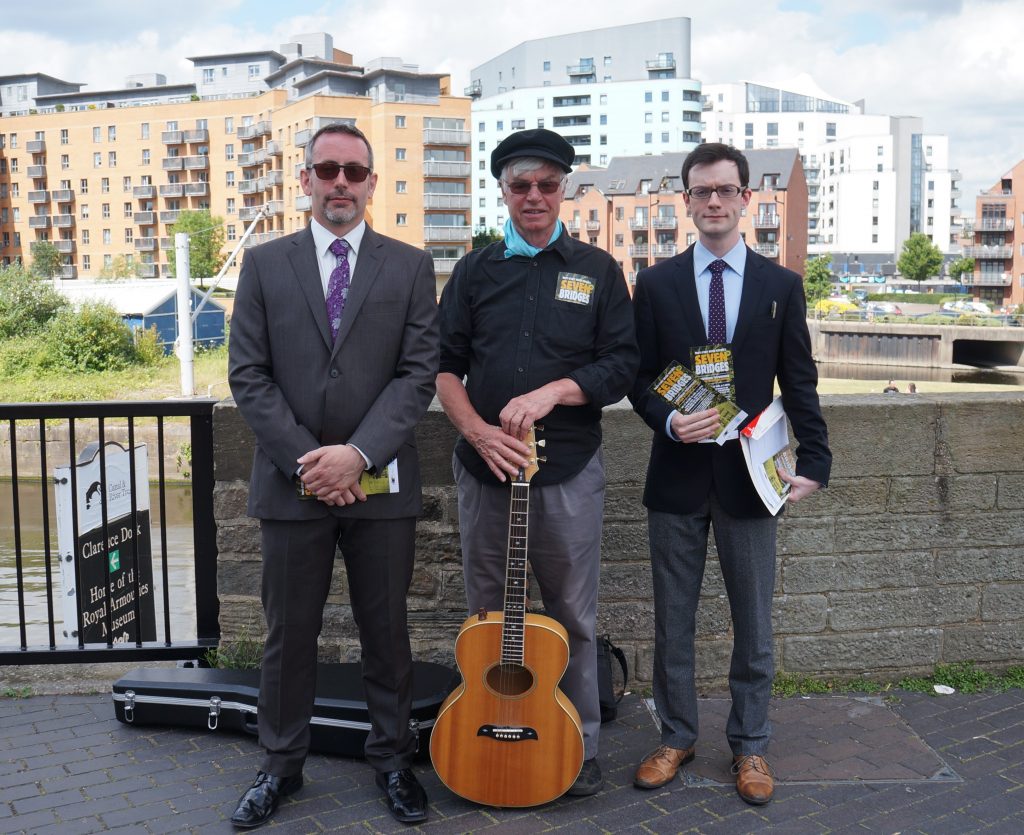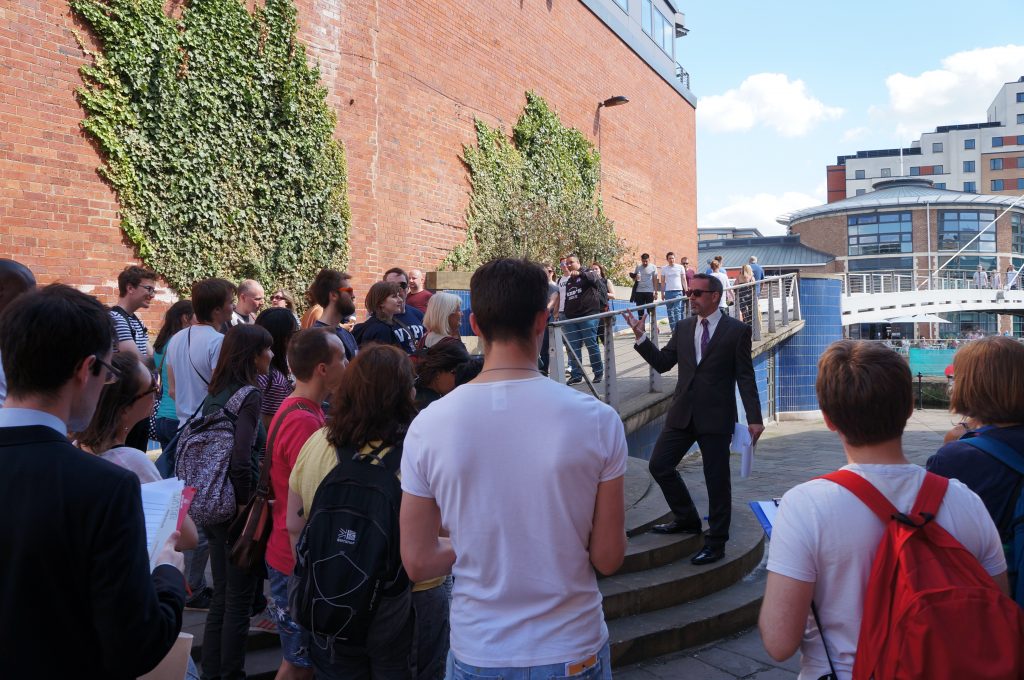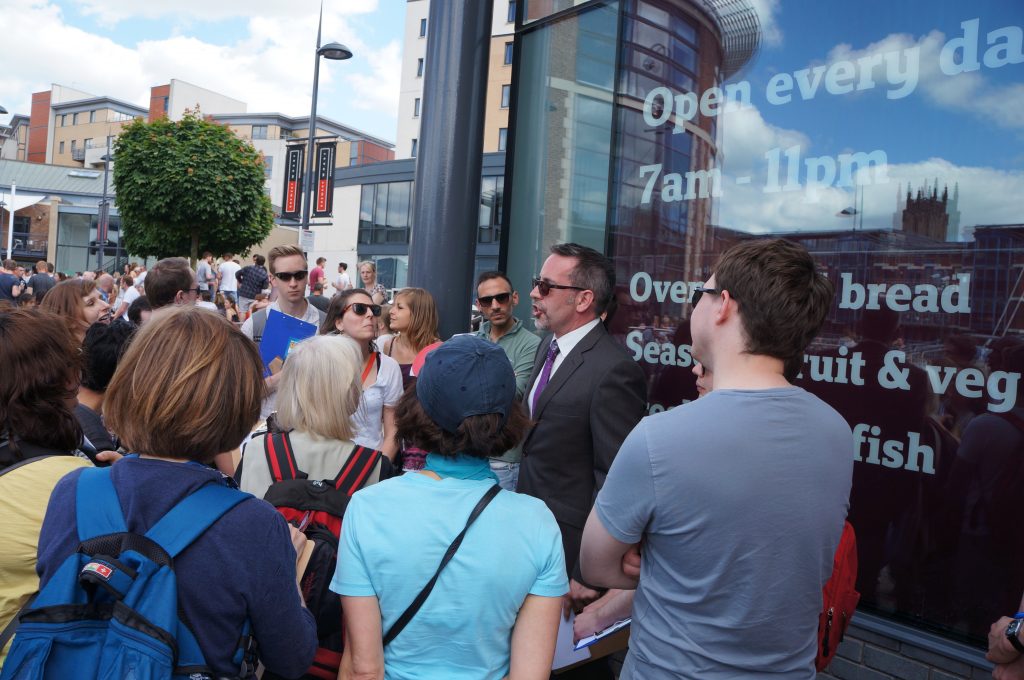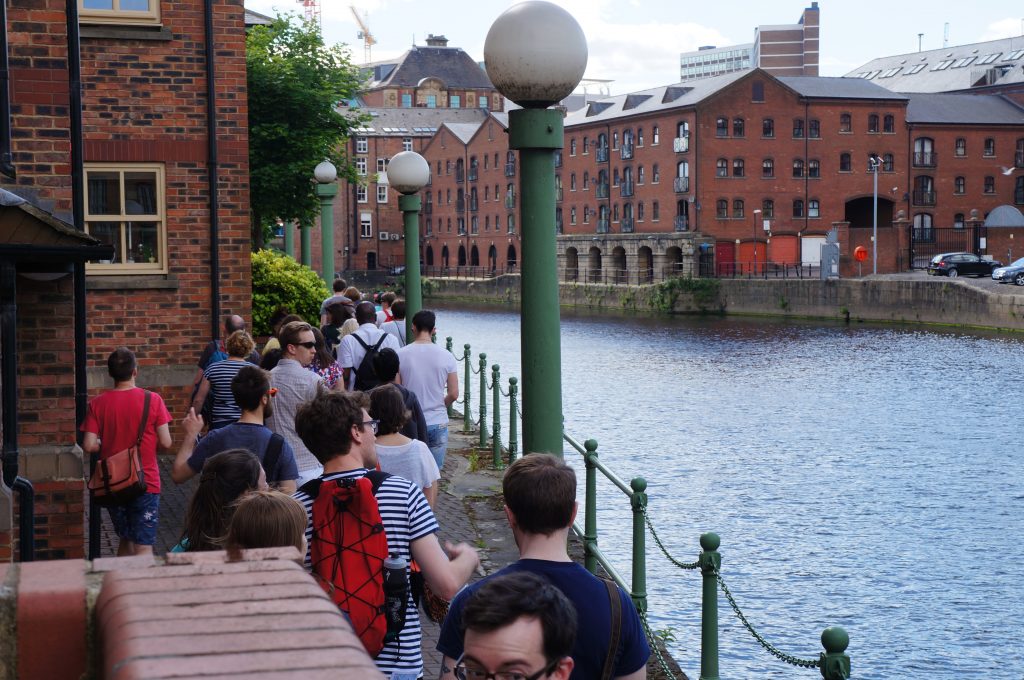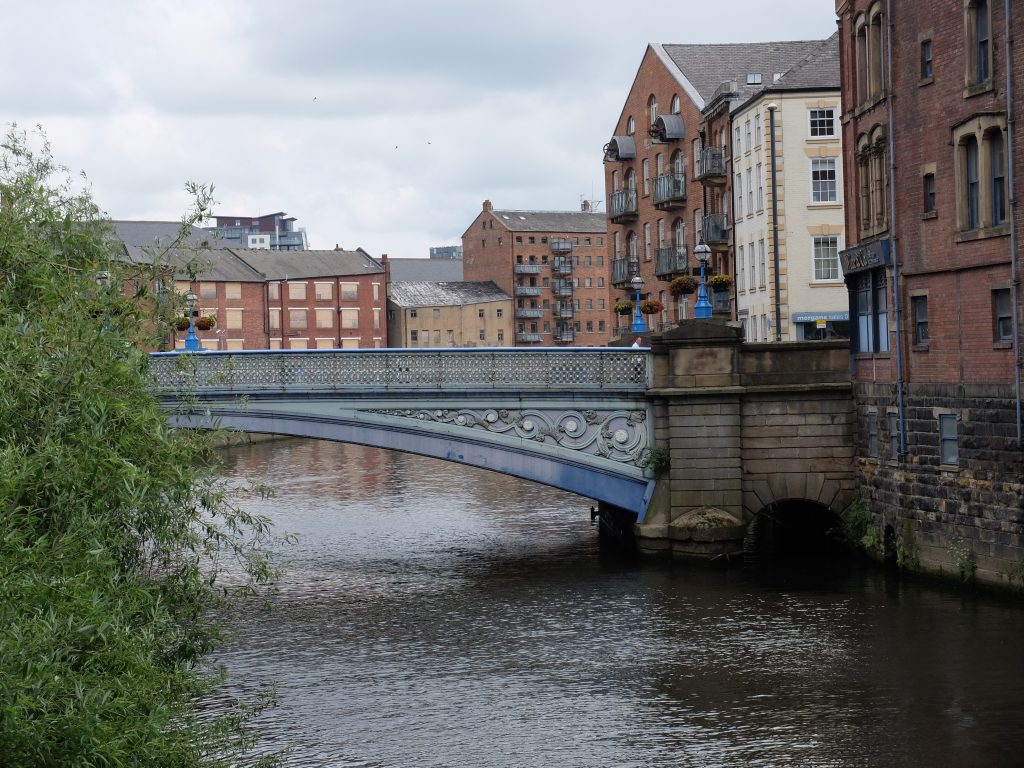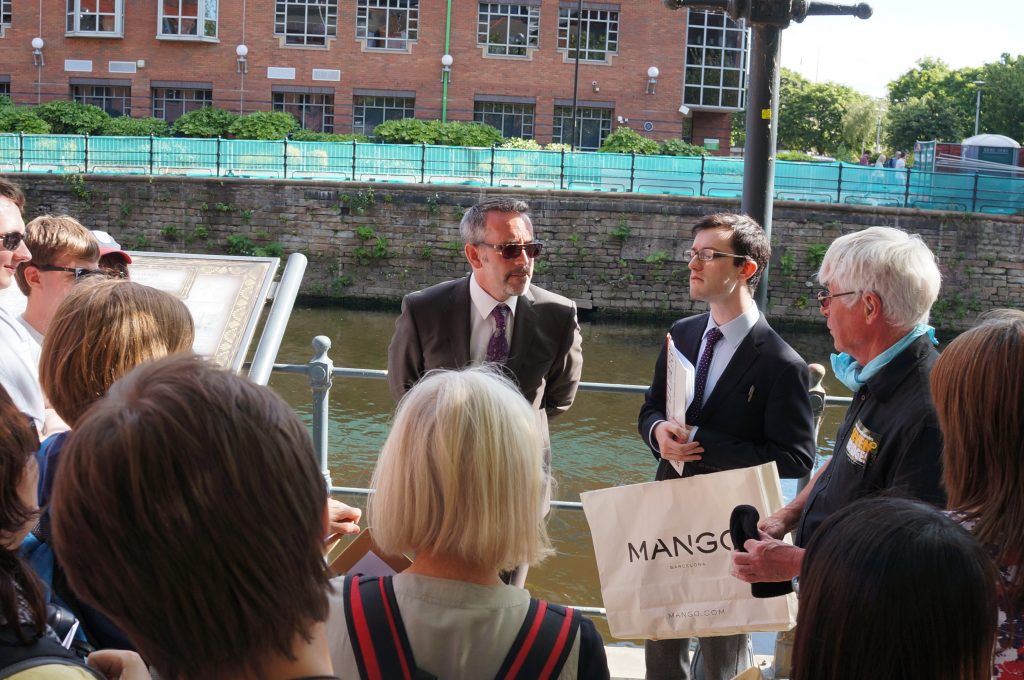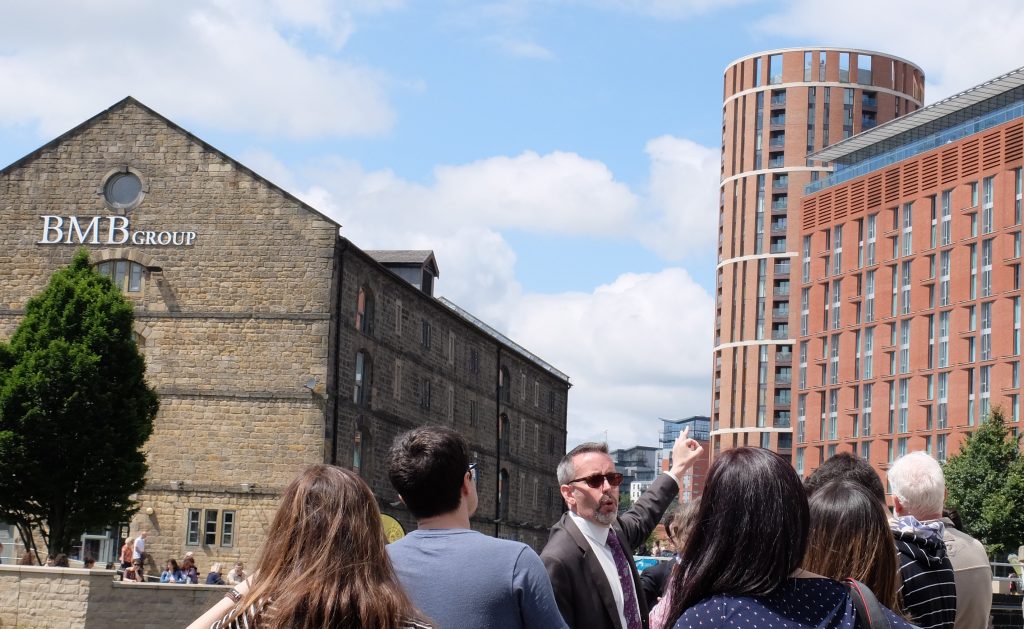Seven Bridges was a guided promenade tour of Leeds’s city centre waterfront, which worked its way west from Leeds Dock to Granary Wharf, by navigating a zig-zag journey back and forth across the river via seven bridges. This piece was Multi-Story Water’s first contribution to the annual Leeds Waterfront Festival — beginning and ending at two of the main festival sites. Premiering in 2015, it was remounted in 2016 at the request of the Waterfront Festival. (Photos courtesy of Tori Watson)
Your tour guides were (from left to right above): Steve Bottoms, Eddie Lawler and David Calder. Eddie played himself, providing musical book-ends at the start and finish of the tour, while Steve and David — suited and booted — adopted the roles of “Don Freshwater” and “Ron Brackish”, respectively the Chief Executive Officer and Chief Executive Assistant to the Chief Executive of the fictional “Leeds Re-Development Corporation” (LRDC).
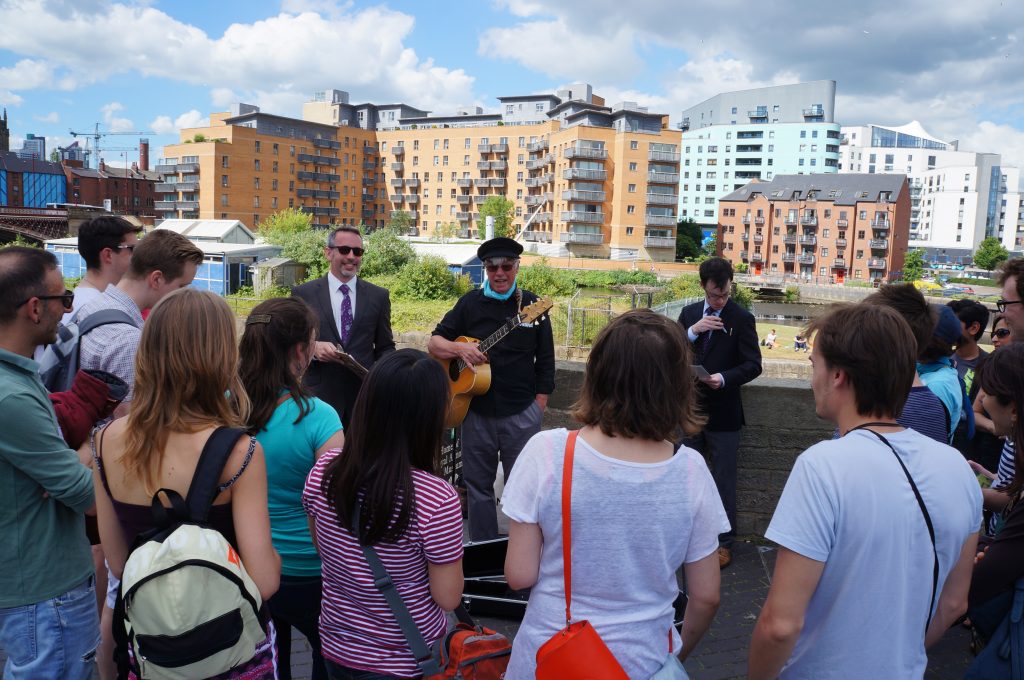 In 2015, Seven Bridges (Leeds) ran on the same late June weekend as its partner piece of the same title, Seven Bridges (Shipley), created for the simultaneous Shipley Street Arts Festival, 12 miles upstream. The two pieces thus created a conceptual “bridge” between festivals, but they were also very different. Leeds’s waterfront landscape is much more built-up and “redeveloped” than Shipley’s quieter, smaller-scale equivalent. So where the Shipley piece adopted a deliberately quiet, reflective approach, the Leeds version was broader and more satirical — using Don and Ron and the LRDC to offer an irreverent swipe at the corporate pretensions of urban waterside development.
In 2015, Seven Bridges (Leeds) ran on the same late June weekend as its partner piece of the same title, Seven Bridges (Shipley), created for the simultaneous Shipley Street Arts Festival, 12 miles upstream. The two pieces thus created a conceptual “bridge” between festivals, but they were also very different. Leeds’s waterfront landscape is much more built-up and “redeveloped” than Shipley’s quieter, smaller-scale equivalent. So where the Shipley piece adopted a deliberately quiet, reflective approach, the Leeds version was broader and more satirical — using Don and Ron and the LRDC to offer an irreverent swipe at the corporate pretensions of urban waterside development. 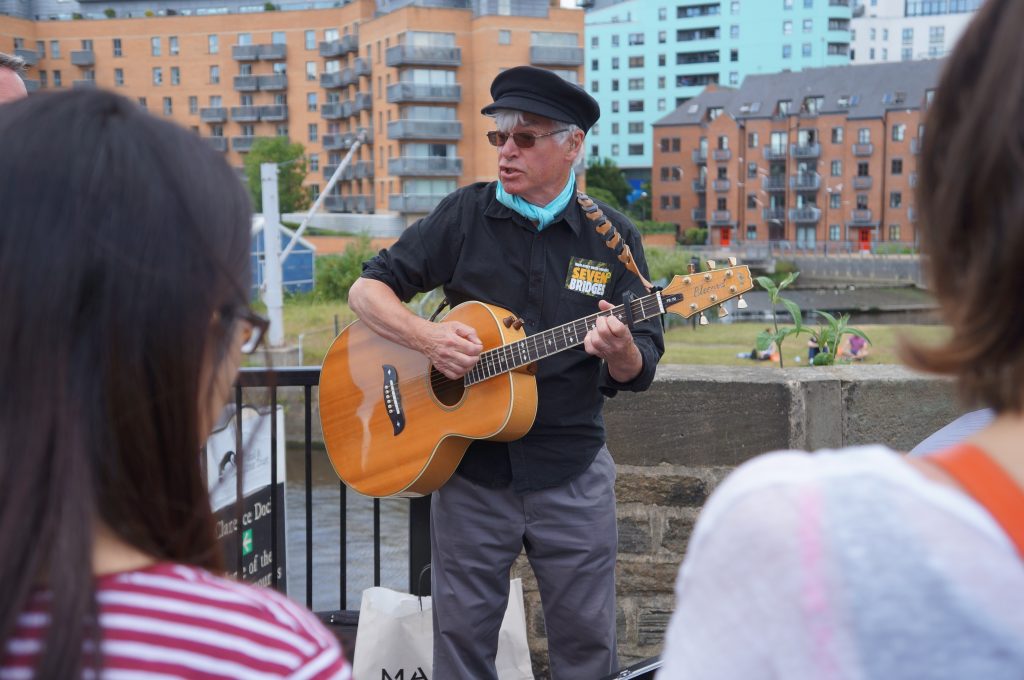 The tour begins on a bridge, of sorts — the walkway that crosses the mouth of Leeds Dock where it opens onto a canalised section of the River Aire, which takes boats around the Leeds Dam weir. This is all part of the Aire and Calder Navigation, a major historical waterway development which opened in 1704, allowing large-scale shipping to come 70 miles inland to Leeds, via the Humber, from the North Sea. Eddie’s opening song is an updated version of a “broadsheet ballad” from the early 18th Century, “When Leeds Becomes a Seaport Town“. As the title indicates, the song is a satirical dig at urban aspirations. It also has a great, singalong chorus, to help gather an audience at the start of the tour…
The tour begins on a bridge, of sorts — the walkway that crosses the mouth of Leeds Dock where it opens onto a canalised section of the River Aire, which takes boats around the Leeds Dam weir. This is all part of the Aire and Calder Navigation, a major historical waterway development which opened in 1704, allowing large-scale shipping to come 70 miles inland to Leeds, via the Humber, from the North Sea. Eddie’s opening song is an updated version of a “broadsheet ballad” from the early 18th Century, “When Leeds Becomes a Seaport Town“. As the title indicates, the song is a satirical dig at urban aspirations. It also has a great, singalong chorus, to help gather an audience at the start of the tour…
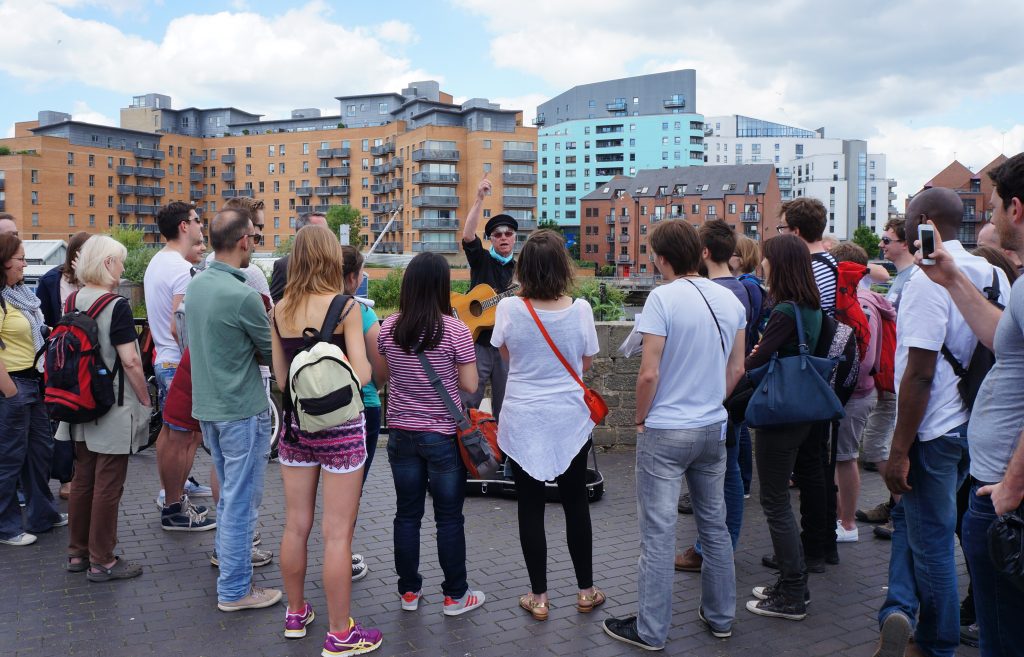 Following Eddie’s song, Don and Ron introduce themselves by showing off the wonders of Leeds Dock, formerly New Dock, formerly Clarence Dock. There is still signage with all three names visible, so the place has a bit of an identity crisis!
Following Eddie’s song, Don and Ron introduce themselves by showing off the wonders of Leeds Dock, formerly New Dock, formerly Clarence Dock. There is still signage with all three names visible, so the place has a bit of an identity crisis!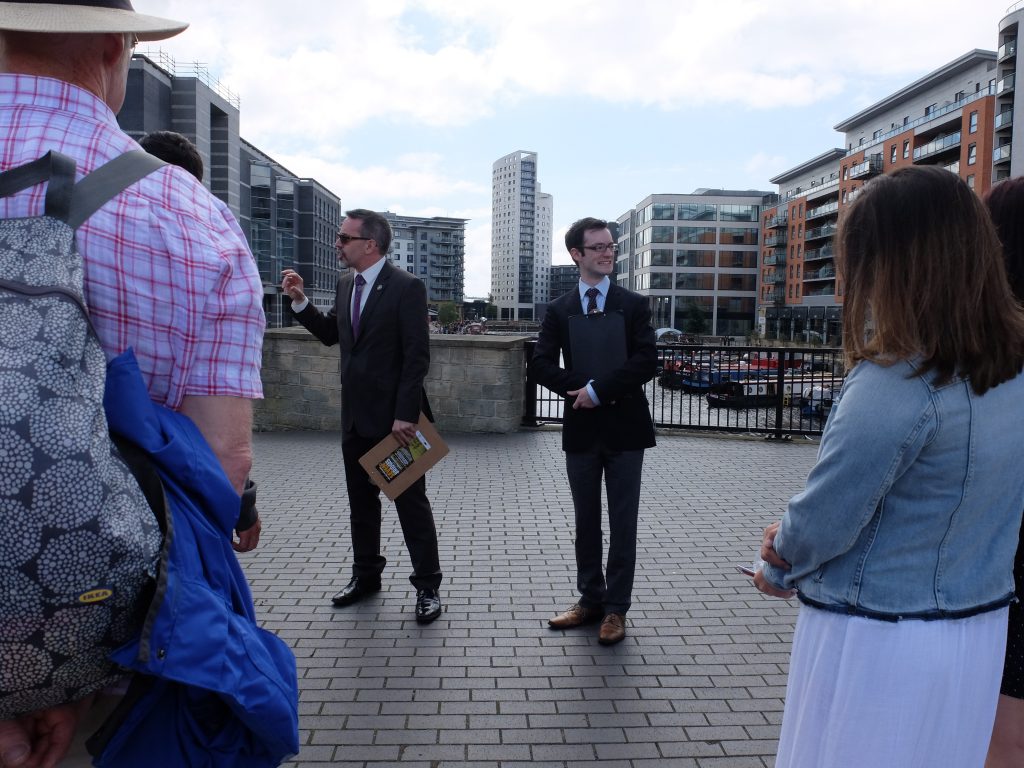
Forcibly purchased from the navigation’s warehouse owners in the early 1990s, Leeds Dock was transformed at the behest of the (non-fictional) Leeds Development Corporation into a high-end retail and apartment complex, as part of the city’s new vision for a post-industrial service economy. But under a series of different site owners, the complex has struggled to attract visitors and turn a profit. Perhaps, Don suggests, they got the branding wrong. Perhaps a re-branding and RE-Development is required…
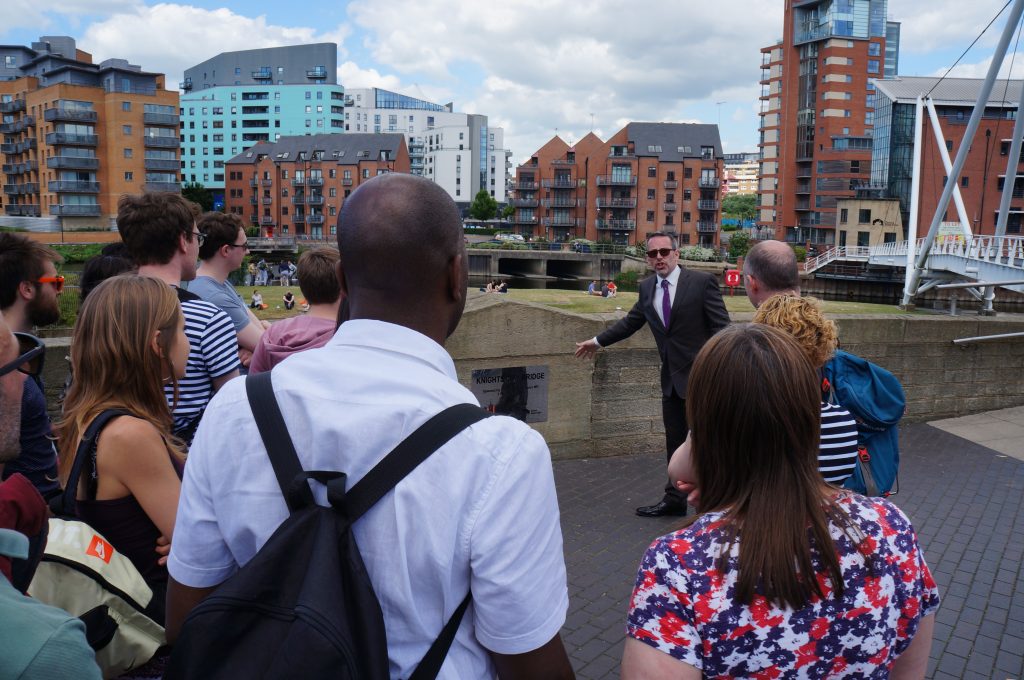 To explain the concept of re-branding, Don points out a plaque on the wall, marking the opening of Knights’ Way Bridge in 2007 (a suspension footbridge which marked another attempt to attract footfall in towards Leeds Dock). On the plaque is the logo for British Waterways, which in 2012 was re-branded as the Canal and River Trust, or CRT (with its logo morphing from a bridge to a swan). Don then invites the audience to follow him across Knights’ Way Bridge towards the CRT building opposite. (Bridge 1 of 7.)
To explain the concept of re-branding, Don points out a plaque on the wall, marking the opening of Knights’ Way Bridge in 2007 (a suspension footbridge which marked another attempt to attract footfall in towards Leeds Dock). On the plaque is the logo for British Waterways, which in 2012 was re-branded as the Canal and River Trust, or CRT (with its logo morphing from a bridge to a swan). Don then invites the audience to follow him across Knights’ Way Bridge towards the CRT building opposite. (Bridge 1 of 7.)
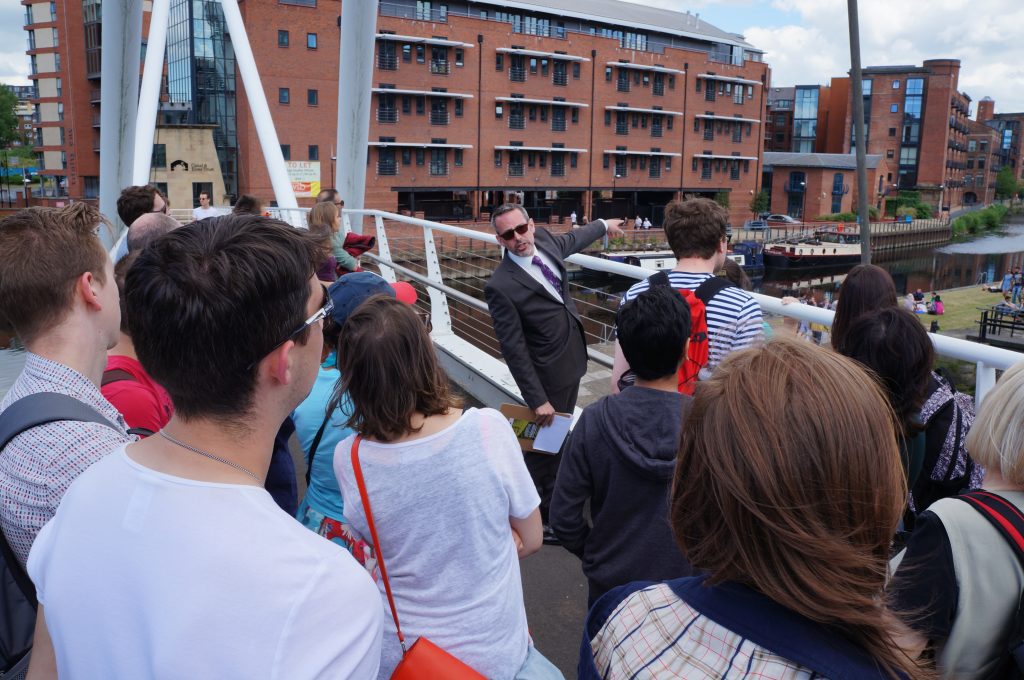 We pause briefly, mid-bridge, for Don to point out the Rose Wharf building just downstream, headquarters of the ARUP engineering consultancy. Historically, he points out, there was never a wharf there for roses… Nifty re-branding!
We pause briefly, mid-bridge, for Don to point out the Rose Wharf building just downstream, headquarters of the ARUP engineering consultancy. Historically, he points out, there was never a wharf there for roses… Nifty re-branding!
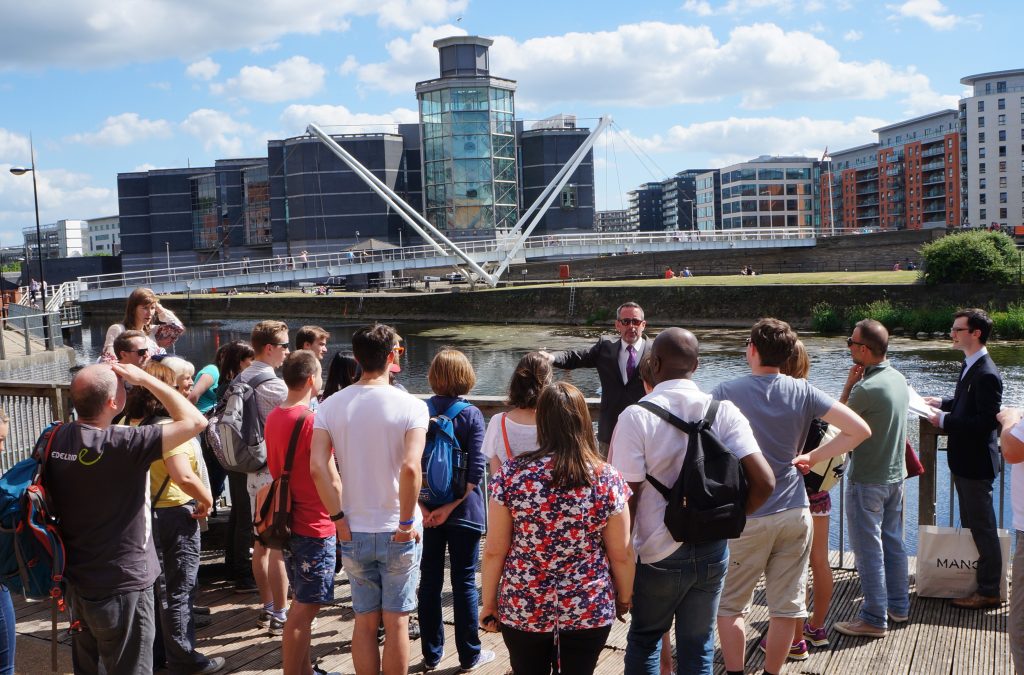 Having crossed Knights’ Way Bridge, we gather on the north bank overlooking the Leeds Dam weir (and looking back – in the picture above – towards the bridge, the Royal Armouries and Leeds Dock). Here Don and Ron briefly explain the current re-development plans for this very site — where the old industrial weir will be replaced by a state-of-the-art, collapsible, pneumatic weir (developed by ARUP) as part of the Leeds Flood Alleviation Scheme. (Two years later, what had seemed like science-fiction in 2015 was a reality – and the focus of our 2017 Waterfront Festival piece, Weir Science.)
Having crossed Knights’ Way Bridge, we gather on the north bank overlooking the Leeds Dam weir (and looking back – in the picture above – towards the bridge, the Royal Armouries and Leeds Dock). Here Don and Ron briefly explain the current re-development plans for this very site — where the old industrial weir will be replaced by a state-of-the-art, collapsible, pneumatic weir (developed by ARUP) as part of the Leeds Flood Alleviation Scheme. (Two years later, what had seemed like science-fiction in 2015 was a reality – and the focus of our 2017 Waterfront Festival piece, Weir Science.)
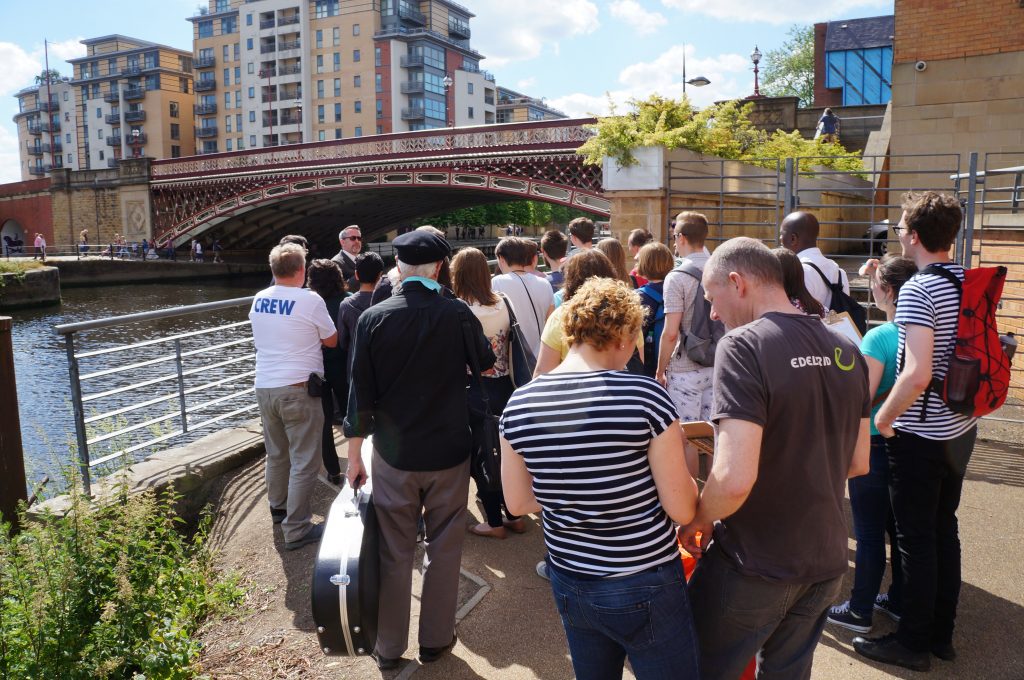 From the weir, it’s just a short walk west towards Bridge #2, Crown Point Bridge — an elaborate wrought-iron road bridge dating from 1840 — but widened in 1994 to accommodate a dual carriageway (all part of Leeds’ 1990s re-development). Climbing up onto the bridge and crossing the road (at some risk to our lives!) we descend to the far side and continue walking west via the riverside footpath…
From the weir, it’s just a short walk west towards Bridge #2, Crown Point Bridge — an elaborate wrought-iron road bridge dating from 1840 — but widened in 1994 to accommodate a dual carriageway (all part of Leeds’ 1990s re-development). Climbing up onto the bridge and crossing the road (at some risk to our lives!) we descend to the far side and continue walking west via the riverside footpath…
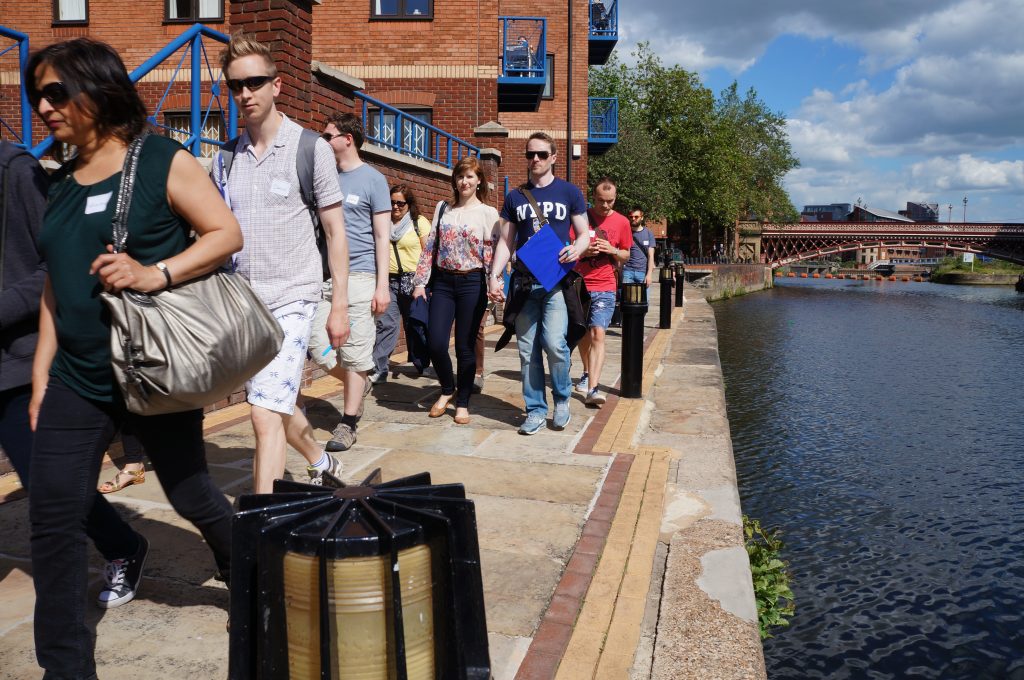 Although it looks open, this pathway is not a public right of way, Don and Ron point out. Nor indeed is anything beside the Aire in Leeds city centre. All the land belongs to the owners of the apartment complexes we are passing (and before that, to the owners of the warehouses and mills that stood on the river’s banks). So this is merely a “permissive pathway”: we use it with permission, which can be withdrawn at any time. Don and Ron think this is great, just as it should be, and take great pleasure in pointing out all the signage declaring these areas to be PRIVATE, covered by CCTV. (See this blog post, from the research stages for this piece, for related images and observations.)
Although it looks open, this pathway is not a public right of way, Don and Ron point out. Nor indeed is anything beside the Aire in Leeds city centre. All the land belongs to the owners of the apartment complexes we are passing (and before that, to the owners of the warehouses and mills that stood on the river’s banks). So this is merely a “permissive pathway”: we use it with permission, which can be withdrawn at any time. Don and Ron think this is great, just as it should be, and take great pleasure in pointing out all the signage declaring these areas to be PRIVATE, covered by CCTV. (See this blog post, from the research stages for this piece, for related images and observations.)
And so we come to Bridge #3, Centennial Bridge — designed by Arup and built in the early 1990s. It was part of the Leeds Development Corporation’s bid to open up the South Bank to pedestrian traffic coming from the city centre, via the Calls (whose cobbled streets we have had to duck around to get back to the river, when we ran out of path). This bridge was opened by Michael Howard MP, of whom (Don reminds us) Ann Widdecombe famously remarked: “there is something of the night about him.”
After pausing briefly, while crossing the bridge, to consider the love-locks padlocked to its rails (Ron: “Get your own thing, Leeds!”), we arrive at Brewery Wharf. Despite its name, this was never actually a wharf area for the nearby Tetley brewery: historically it was a cleansing depot, but was rebranded in (you guessed it) the early 1990s when the LDC worked with Tetley’s to build an interactive museum of the brewing industry… (which very quickly closed and got turned into yet more apartments, bars, restaurants. Though frequently more or less deserted, Brewery Wharf was rammed with drinkers and bands over the 2015 Festival weekend, forcing our tour to take refuge in the lee of Sainsbury’s Local…
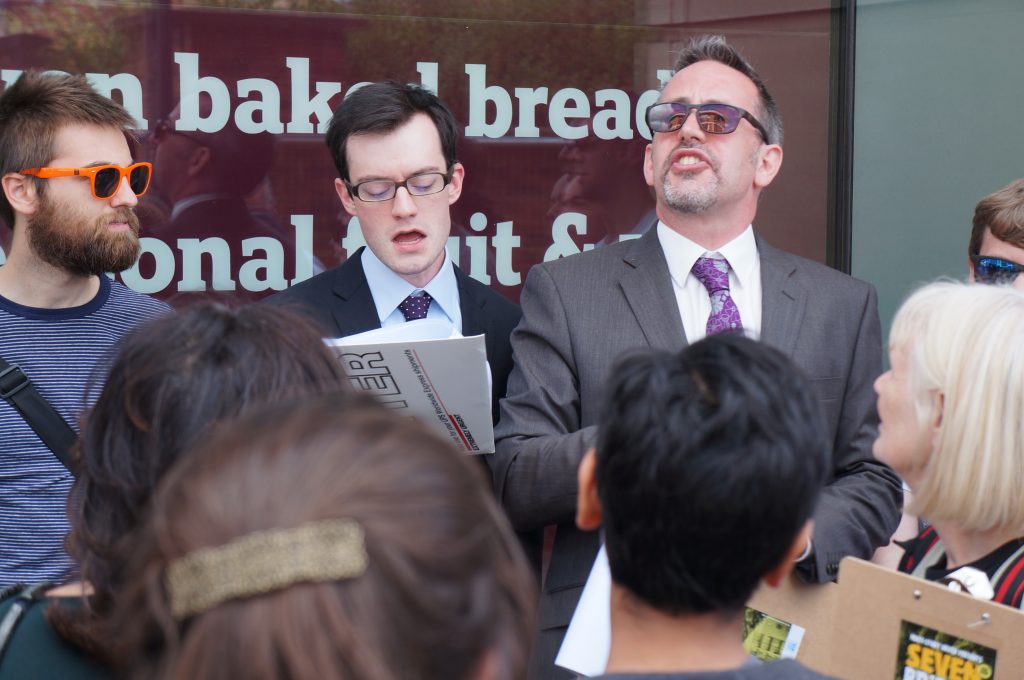 Here, shouting to make themselves heard over amplified band noise, Ron and Don do some of their very best inadvertent gurning, as they explain Brewery Wharf’s patchy history of redevelopment. And then it’s onwards again, into the private apartment complex that is Victoria Quays. Once the headquarters of the Aire and Calder Navigation Company, the dock here was formerly roofed over…
Here, shouting to make themselves heard over amplified band noise, Ron and Don do some of their very best inadvertent gurning, as they explain Brewery Wharf’s patchy history of redevelopment. And then it’s onwards again, into the private apartment complex that is Victoria Quays. Once the headquarters of the Aire and Calder Navigation Company, the dock here was formerly roofed over…
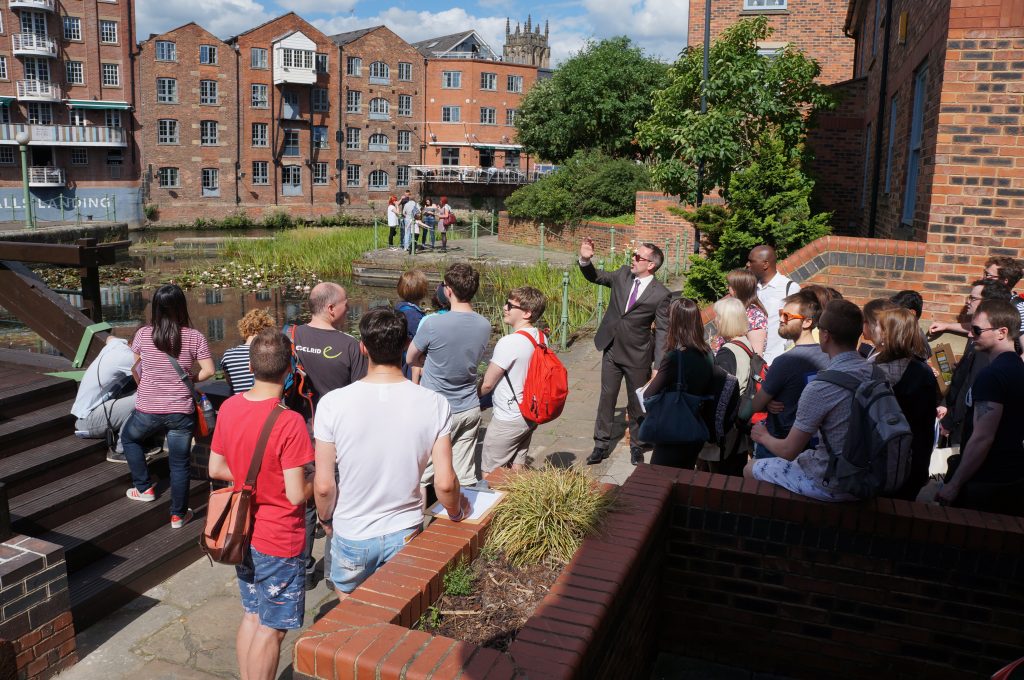 Don points out that this whole area is private residential space, once again riddled with CCTV signage. Even the bridge across the dock, he says, is clearly marked as being PRIVATE, for residents’ use only. But since we need to use it to continue our riverside walk, we have sought written permission to do so, haven’t we Ron? (Ron shuffles around with his paperwork, can’t find the permission letter…) Oh dear, Don remarks, well are we happy to cross without written permission? We could go a longer way round instead. Let’s have a show of hands…
Don points out that this whole area is private residential space, once again riddled with CCTV signage. Even the bridge across the dock, he says, is clearly marked as being PRIVATE, for residents’ use only. But since we need to use it to continue our riverside walk, we have sought written permission to do so, haven’t we Ron? (Ron shuffles around with his paperwork, can’t find the permission letter…) Oh dear, Don remarks, well are we happy to cross without written permission? We could go a longer way round instead. Let’s have a show of hands…
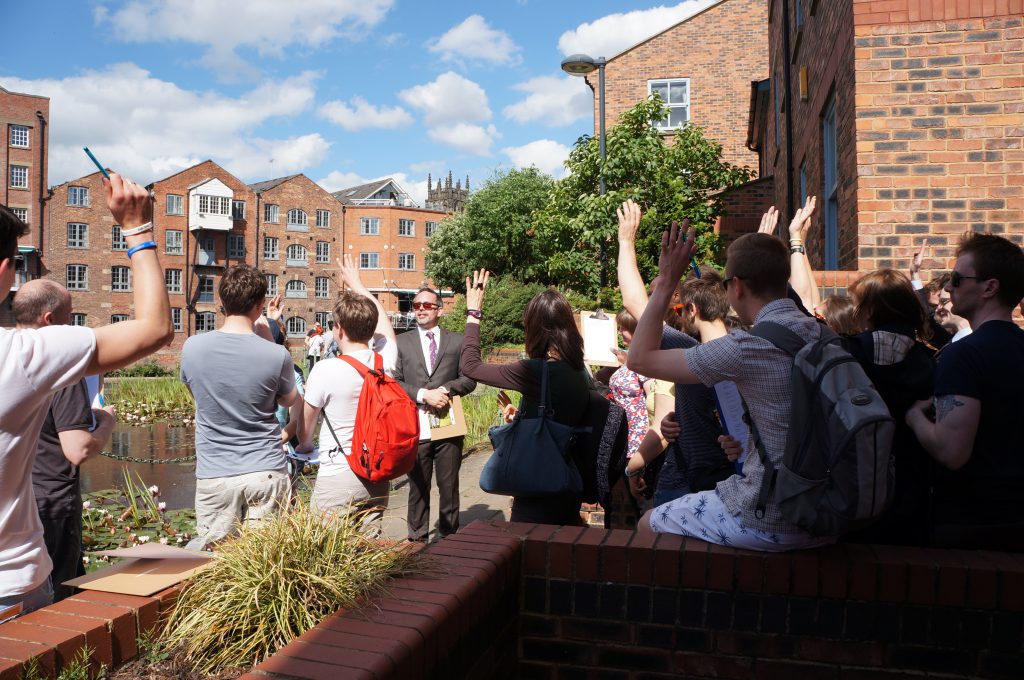 Every time we have done this tour, participants vote almost unanimously to cross the bridge regardless. We’ve had a few abstentions, but never a single no vote.
Every time we have done this tour, participants vote almost unanimously to cross the bridge regardless. We’ve had a few abstentions, but never a single no vote.
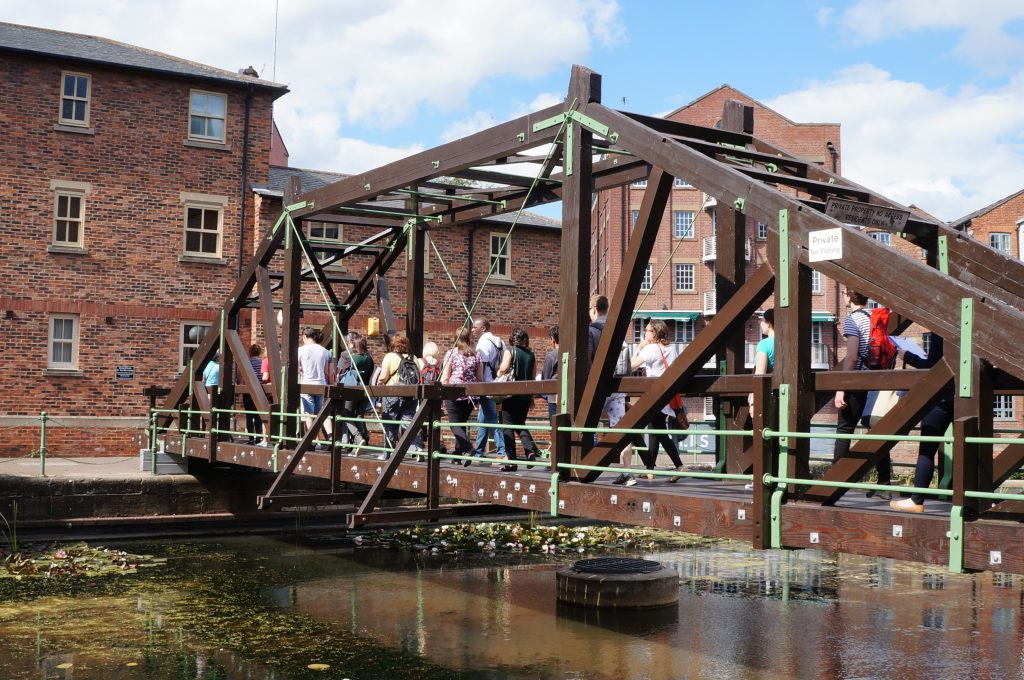 Working our way back round to the narrow riverside path, we continue west…
Working our way back round to the narrow riverside path, we continue west…
We pause opposite a car park and some boarded-up office buildings. The area you can see here, Don tells us, is “Warehouse Hill” — for centuries a key loading area for freight boats. It is also believed to be from this piece of riverbank that, in 1969, that a homeless Nigerian immigrant named David Oluwale was “pushed or caused to fall” into the river by members of the Leeds City Police. He turned up dead at Knostrop weir, days later.
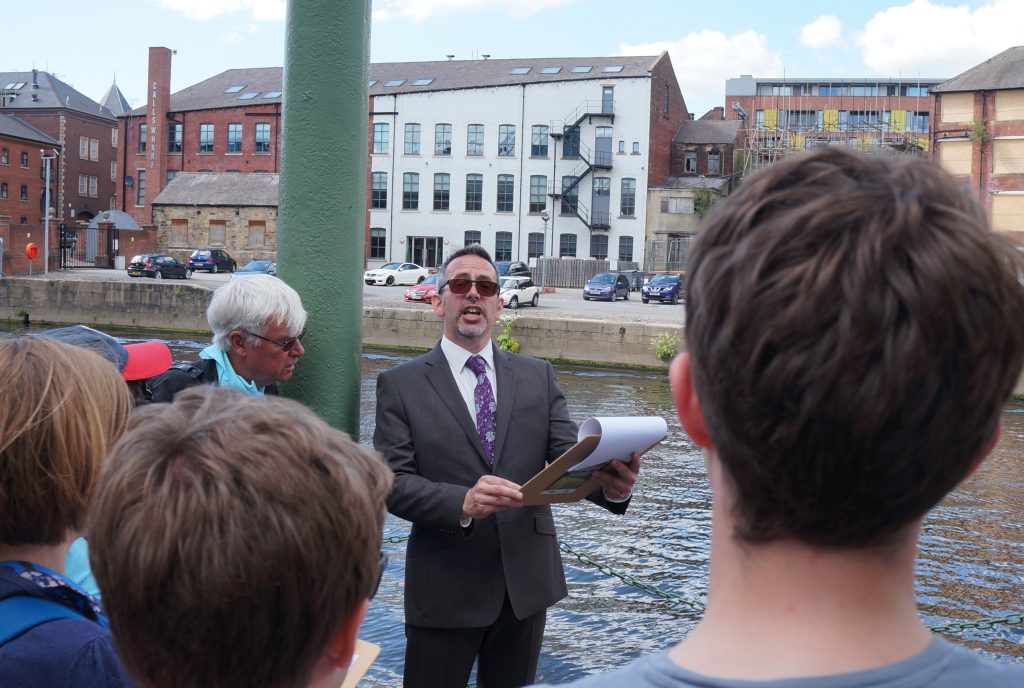 CEO Don tells us this story of alleged racist police brutality because he feels it is the sort of thing that shiny, modern Leeds does not need to be remembered by. Perhaps this unsightly, forgotten area opposite needs to be re-developed, forthwith, with more steel and glass, so as to banish the uncomfortable ghost of Mr. Oluwale. That story got far too much publicity, in Don’s view: it even got turned into a song for Leeds United supporters to chant at the police, at Elland Road… Accompanied by Eddie on guitar, Don sings the song to demonstrate (to the tune of “My Old Man said Follow the Van”):
CEO Don tells us this story of alleged racist police brutality because he feels it is the sort of thing that shiny, modern Leeds does not need to be remembered by. Perhaps this unsightly, forgotten area opposite needs to be re-developed, forthwith, with more steel and glass, so as to banish the uncomfortable ghost of Mr. Oluwale. That story got far too much publicity, in Don’s view: it even got turned into a song for Leeds United supporters to chant at the police, at Elland Road… Accompanied by Eddie on guitar, Don sings the song to demonstrate (to the tune of “My Old Man said Follow the Van”):
“Policeman said get in the van, Don’t dilly-dally on the way… They had him in the van and in half a minute, they were down to the river and they dropped him in it… Cos he’d dillied and dallied, dallied and dillied, lost his way and didn’t know where to roam… No you can’t trust a copper when your name’s Oluwale and you can’t find your way home.”
This sequence invariably prompted a mix of horrified stares, suppressed giggling, and general awkwardness about how to respond. Don, of course, was oblivious to this (even if Steve wasn’t), and ploughed on regardless, heading for Bridge End…
 The Bridge End area (we’re pictured here just outside the Adelphi heritage pub) is so called because it is at the south end of Leeds Bridge (our Bridge #4 – we didn’t count the “shy bridge” over the dock at Victoria Quays). The area is highly prestigious, Don notes: it must be, because there’s a proliferation of blue wall plaques. One of them even commemorates the very first extant piece of moving picture footage, shot here on Leeds Bridge in 1888 by Louis Le Prince (Ron has to correct Don’s French pronunciation). If you haven’t heard of Louis Le Prince, well that might be because his career ended prematurely: he too is thought to have ended up drowned in a river… possibly at the hands of foul play from his competitors…? (Don seems oddly fixated on drownings.)
The Bridge End area (we’re pictured here just outside the Adelphi heritage pub) is so called because it is at the south end of Leeds Bridge (our Bridge #4 – we didn’t count the “shy bridge” over the dock at Victoria Quays). The area is highly prestigious, Don notes: it must be, because there’s a proliferation of blue wall plaques. One of them even commemorates the very first extant piece of moving picture footage, shot here on Leeds Bridge in 1888 by Louis Le Prince (Ron has to correct Don’s French pronunciation). If you haven’t heard of Louis Le Prince, well that might be because his career ended prematurely: he too is thought to have ended up drowned in a river… possibly at the hands of foul play from his competitors…? (Don seems oddly fixated on drownings.)
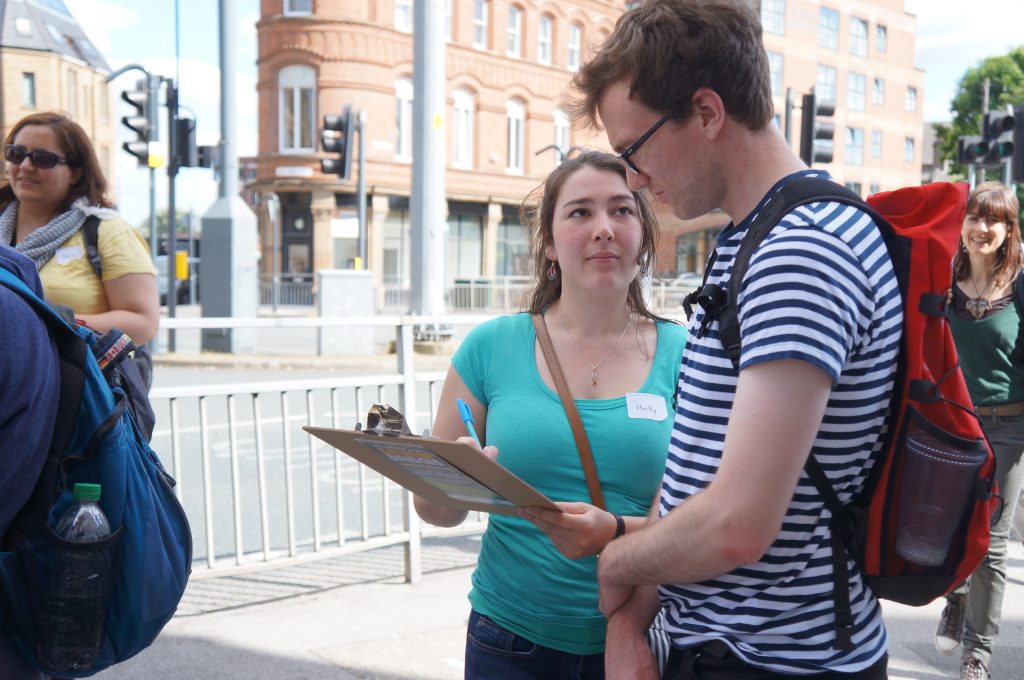 As we navigate our way via pedestrian crossings, across the busy Bridge End intersection, there are moments of pause for walkers to consider their clipboards. Ever since crossing bridge 1, participants have been checking off their own responses to the riverside landmarks being pointed out. There are tick-boxes for LOVE, LIKE, DISLIKE, and CPO (compulsory purchase order: i.e. bulldoze and start again!), as well as space for further comments. Some of them are suitably witty…
As we navigate our way via pedestrian crossings, across the busy Bridge End intersection, there are moments of pause for walkers to consider their clipboards. Ever since crossing bridge 1, participants have been checking off their own responses to the riverside landmarks being pointed out. There are tick-boxes for LOVE, LIKE, DISLIKE, and CPO (compulsory purchase order: i.e. bulldoze and start again!), as well as space for further comments. Some of them are suitably witty…
Leeds Bridge is the oldest bridge in Leeds, dating back at least as far as the 14th century, although the current iron structure is Victorian. It’s crucial to the city’s development as a central regional marketplace (the main shopping street is still Briggate – the way to the bridge).
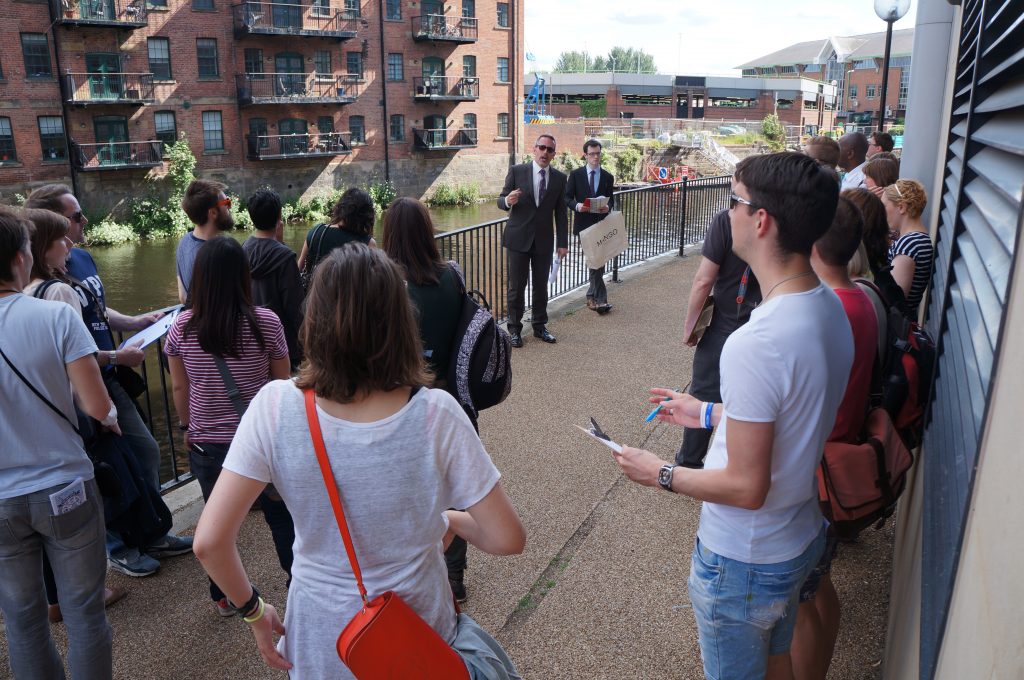 And yet, Don and Ron note — after we’ve crossed back over to the north side, and begin walking west again — much of this central area seems strangely neglected, as if the city has turned its back on the waterfront here. Pointing out the skeletal structure opposite, however, Don specifies that this is not actually an eyesore: it’s a highly expensive, site-specific art installation by Damien Hirst, titled The Unbearable Shiteness of Being…
And yet, Don and Ron note — after we’ve crossed back over to the north side, and begin walking west again — much of this central area seems strangely neglected, as if the city has turned its back on the waterfront here. Pointing out the skeletal structure opposite, however, Don specifies that this is not actually an eyesore: it’s a highly expensive, site-specific art installation by Damien Hirst, titled The Unbearable Shiteness of Being…
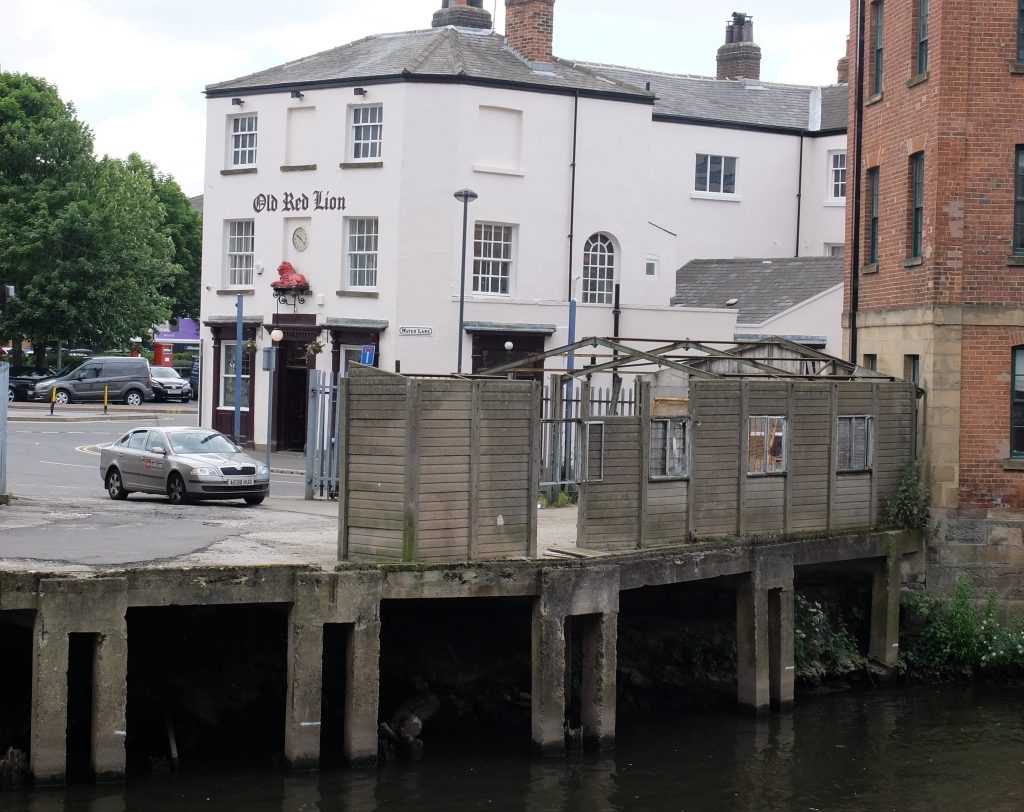 Ron then follows up this cheap but entertaining lie with some campy, off-colour reflections on the Old Red Lion’s past history as a gay bar (not a lie). The gay district has moved across the river now to the bottom of Briggate, but all the world over, Ron notes, “my people” are drawn inexorably to waterfronts, sailors, and other seamen.
Ron then follows up this cheap but entertaining lie with some campy, off-colour reflections on the Old Red Lion’s past history as a gay bar (not a lie). The gay district has moved across the river now to the bottom of Briggate, but all the world over, Ron notes, “my people” are drawn inexorably to waterfronts, sailors, and other seamen.
Continuing upstream, we pause opposite the headquarters of the ASDA supermarket chain, to consider further stories of re-branding (AS-DA is either Associated Dairies, or Asquith + [Associated] Dairies, depending on whether you believe the company was created through a merger or a take-over…). We also note further evidence of the new Leeds Flood Alleviation Scheme, in the form of the green mesh across the river, where works are about to be carried out…
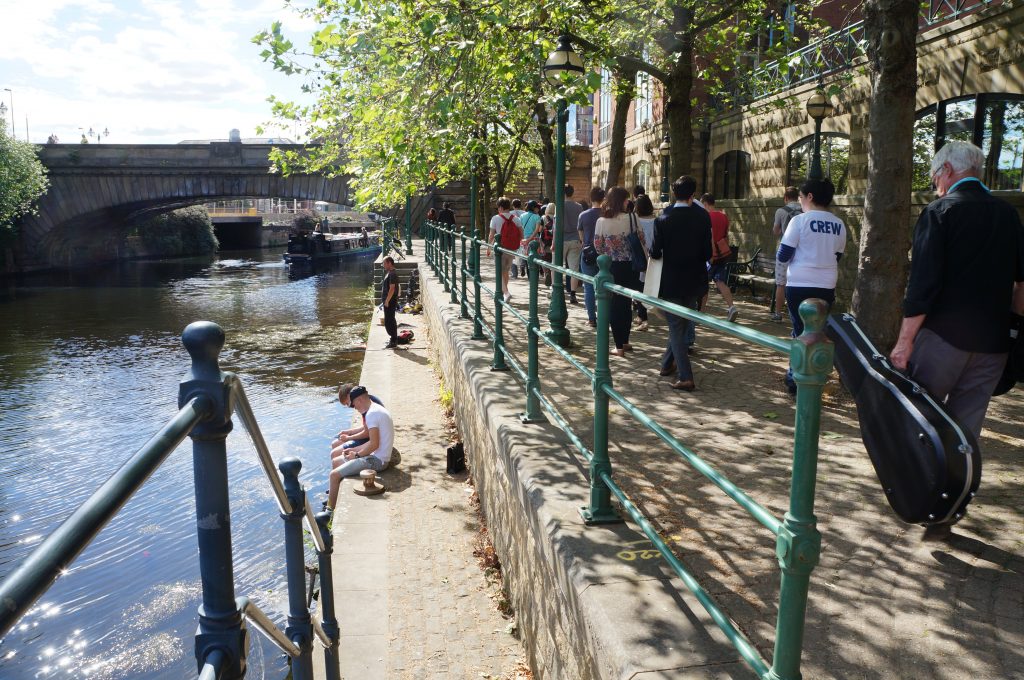 And so we continue, west, towards Victoria Bridge — named for the young Queen Victoria, and built in the aftermath of the Great Flood of 1837… which swept away the timber structure that used to cross the river at this point. Crossing the bridge at road level, we once again descend to the riverbank path at the far side.
And so we continue, west, towards Victoria Bridge — named for the young Queen Victoria, and built in the aftermath of the Great Flood of 1837… which swept away the timber structure that used to cross the river at this point. Crossing the bridge at road level, we once again descend to the riverbank path at the far side.
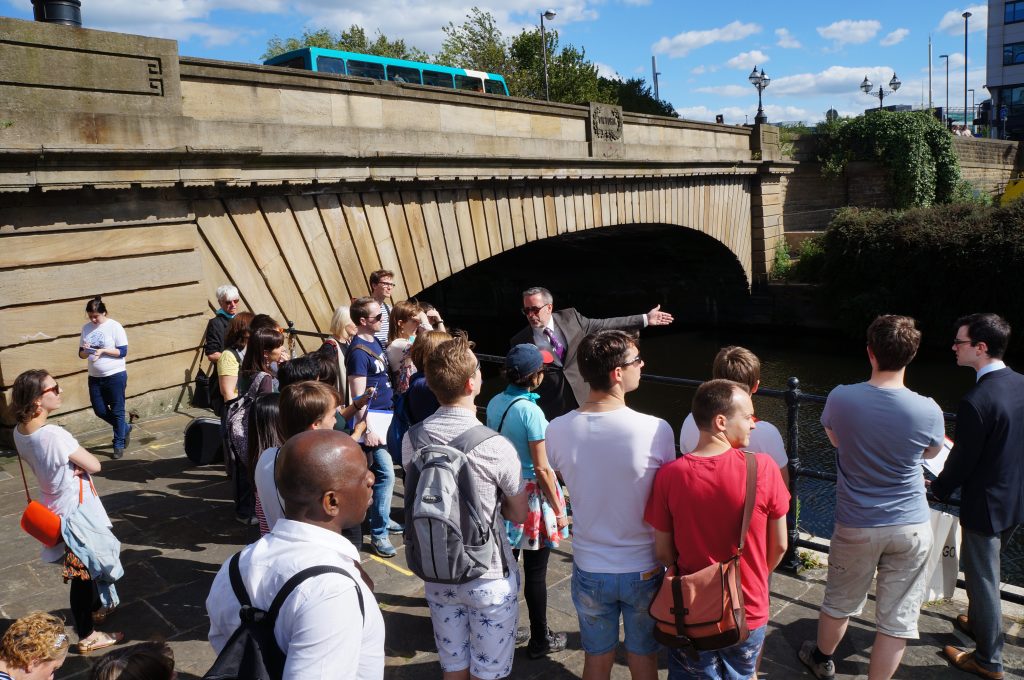 Here we have arrived, Don explains, at the knotted navel of the Leeds waterfront. Across the way, in the shadow of the Bridgewater Place ‘Dalek’ building (see show flyer at the bottom of this page), the Holbeck opens out into the main river. And just yards away from that, the Leeds-Liverpool Canal connects with the Aire…
Here we have arrived, Don explains, at the knotted navel of the Leeds waterfront. Across the way, in the shadow of the Bridgewater Place ‘Dalek’ building (see show flyer at the bottom of this page), the Holbeck opens out into the main river. And just yards away from that, the Leeds-Liverpool Canal connects with the Aire…
Note the contrast here between the old granary building, to the south of the canal lock (now the BMB building), and the new-build Granary Wharf complex, to the north of the canal — completed in the years following the 2008 financial crash. The older building was a granary, but Granary Wharf was never a wharf for grain — historically this was just Canal Wharf. Again, excellent re-branding (a.k.a. lying).
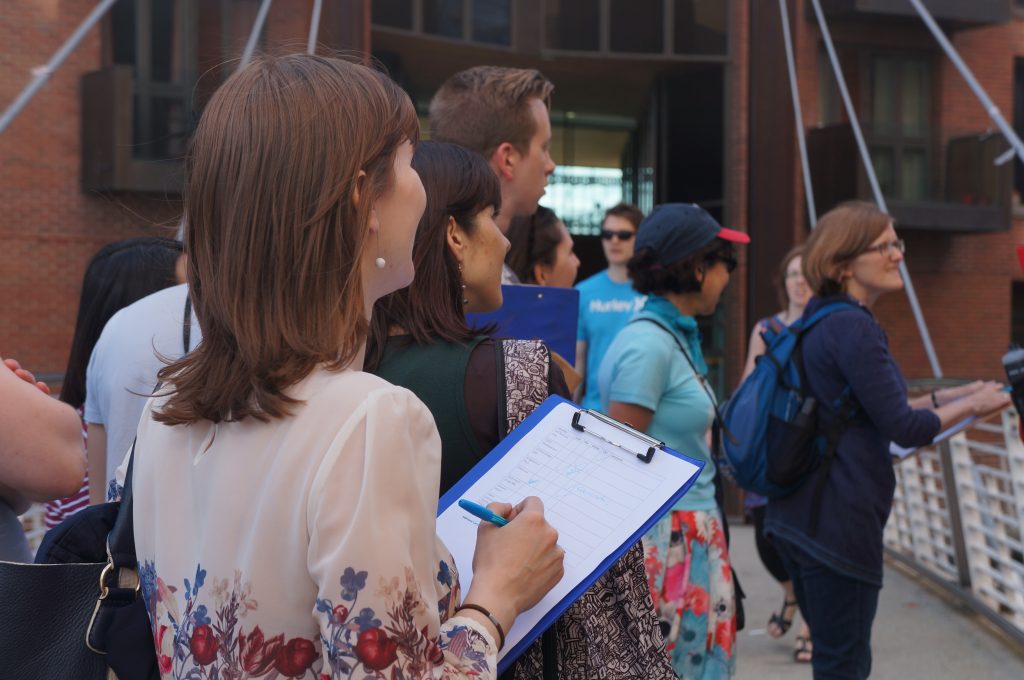
To get to the Granary Wharf plaza, a hub for the Waterfront Festival, we cross over Waterman’s Bridge — Bridge #6 — the newest bridge on the tour. We pause to note the plaque cemented into the floor which specifies that this, too, is not a public right of way, but a private structure. Permission to cross can be revoked at any time…
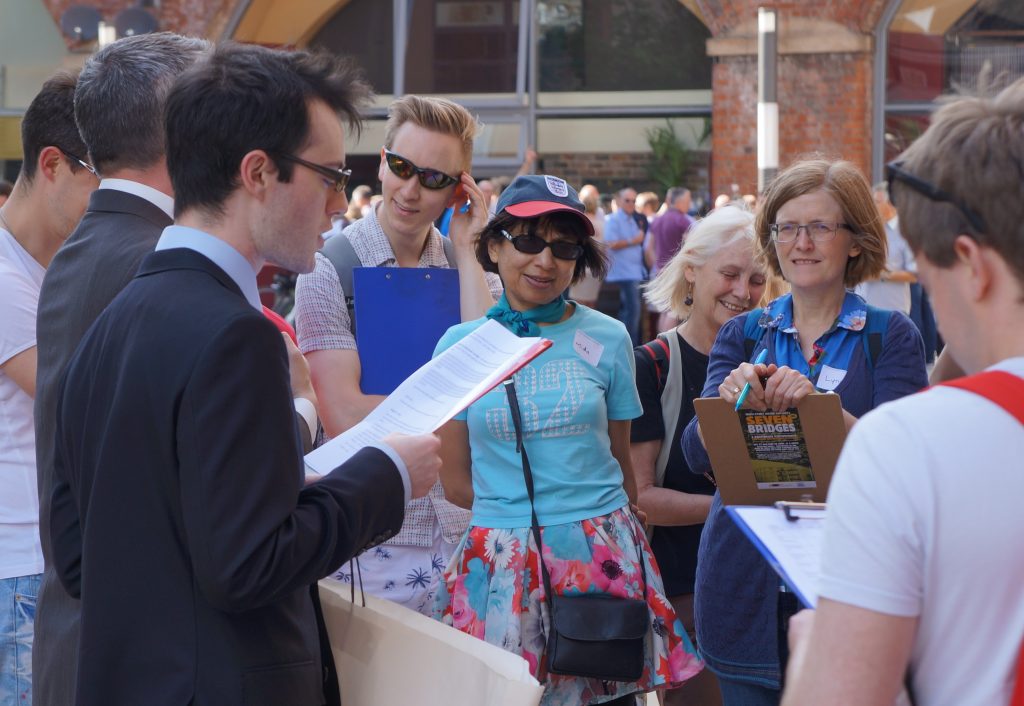 In the Granary Wharf plaza, we pause to consider the development of this exciting new leisure and residential complex! It was built, Ron explains, by ISIS. Yes, ISIS! They’ve got a bad rap, lately, but ISIS is doing great work here. And it’s 50% owned by the Canal and River Trust (formerly British Waterways… the owners of the old canal wharf). Developments like this are helping the Trust become independent from government, in the brave new world of alternative revenue initiatives.
In the Granary Wharf plaza, we pause to consider the development of this exciting new leisure and residential complex! It was built, Ron explains, by ISIS. Yes, ISIS! They’ve got a bad rap, lately, but ISIS is doing great work here. And it’s 50% owned by the Canal and River Trust (formerly British Waterways… the owners of the old canal wharf). Developments like this are helping the Trust become independent from government, in the brave new world of alternative revenue initiatives.
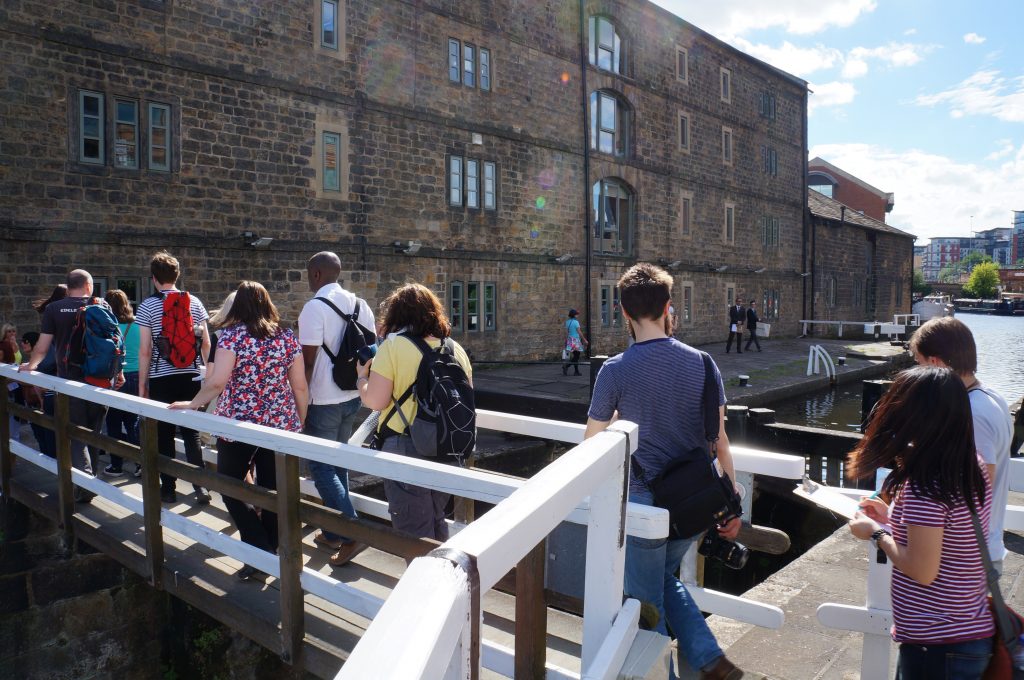 And so, finally, we make our way from Granary Wharf across our seventh and most unassuming bridge — the simple wooden structure that crosses the head of Lock 1 of the canal, as it opens out to the Aire. Humble and anonymous, this bridge is nevertheless a vital crossing point for many city centre pedestrians.
And so, finally, we make our way from Granary Wharf across our seventh and most unassuming bridge — the simple wooden structure that crosses the head of Lock 1 of the canal, as it opens out to the Aire. Humble and anonymous, this bridge is nevertheless a vital crossing point for many city centre pedestrians.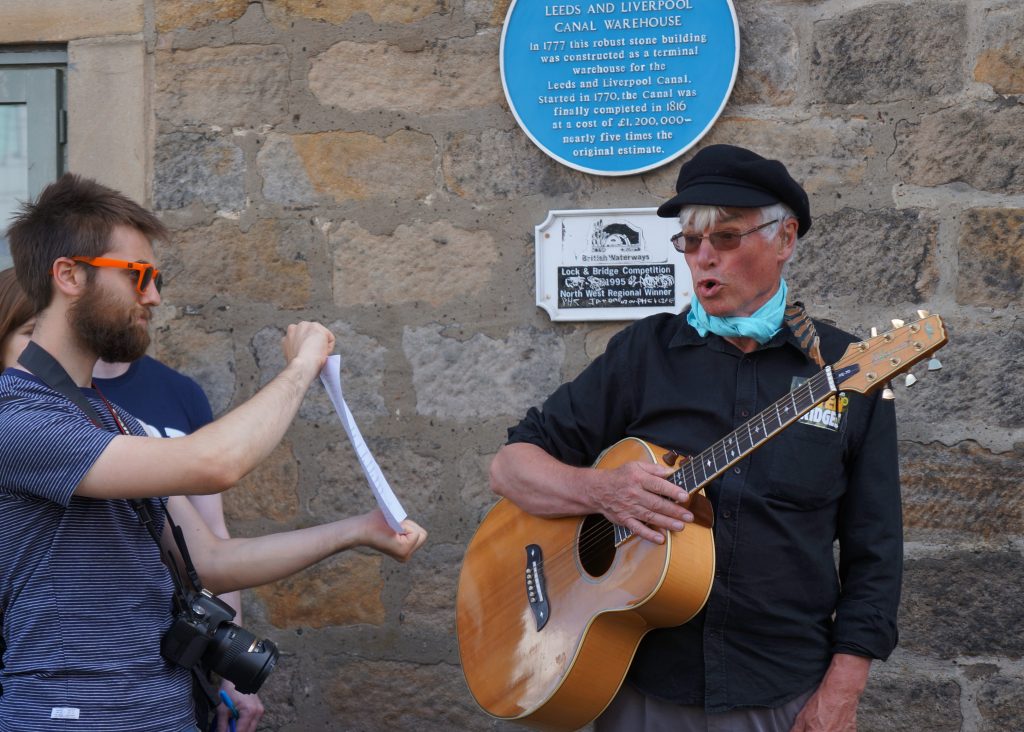 Here, underneath the blue plaque that marks the BMB building’s former life as the Leeds-Liverpool Canal Company’s terminal warehouse, Eddie sings our closing (terminal) song… It’s his own song, “Bradford Canal” — a scurrilous tale of this stinking, filthy and dangerous branch cut, coming off the Leeds-Liverpool at Shipley and connecting to Bradford city centre. The tale of this hated, long filled-in waterway is a humbling reminder that Leeds’s grandiose urban designs owe debts in some unexpected directions… For it was Bradford businessmen who funded the initial construction of the Leeds-Liverpool Canal, in a bid to create trade routes to the sea, to both east and west.
Here, underneath the blue plaque that marks the BMB building’s former life as the Leeds-Liverpool Canal Company’s terminal warehouse, Eddie sings our closing (terminal) song… It’s his own song, “Bradford Canal” — a scurrilous tale of this stinking, filthy and dangerous branch cut, coming off the Leeds-Liverpool at Shipley and connecting to Bradford city centre. The tale of this hated, long filled-in waterway is a humbling reminder that Leeds’s grandiose urban designs owe debts in some unexpected directions… For it was Bradford businessmen who funded the initial construction of the Leeds-Liverpool Canal, in a bid to create trade routes to the sea, to both east and west.
And so Eddie finishes, and we applaud…
Collecting back the audience’s clipboards, we invite them to jot down any thoughts or feedback they have on their experience with us. The feedback was enthusiastic and positive, with some interesting suggestions as to how the waterfront might be improved (redeveloped!) in future. Let’s just close with this response, offered by person(s) unknown after braving a tour plagued by intermittent rain:
Postscript:
Our 2016 remount of Seven Bridges was much the same as the 2015 version, but with a few small revisions and updates. Eddie dropped the bargee outfit, and replaced his final song with a new composition to mark the 2016 Bicentenary of the Leeds-Liverpool, “Canal Child“. Meanwhile, Steve and David had finally memorised the words to “Seaport Town’s” chorus… Whether it was the weather or the publicity, the 2016 festival did not seem to be as heavily attended as the 2015 equivalent. We played to somewhat smaller touring groups, but the upside was that Brewery Wharf was less hideously crowded, so were able to venture into it properly…
Whether it was the weather or the publicity, the 2016 festival did not seem to be as heavily attended as the 2015 equivalent. We played to somewhat smaller touring groups, but the upside was that Brewery Wharf was less hideously crowded, so were able to venture into it properly…
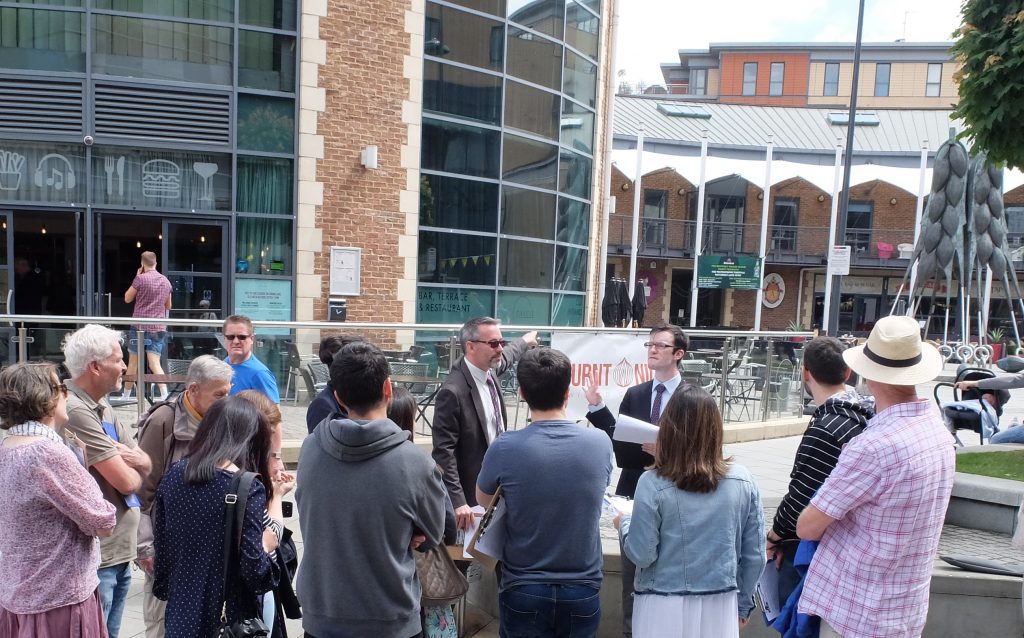 The most significant changes from 2015 to 2016, however, occurred in the landscape itself. This, for example, was the mouth of the dock area at Victoria Quays, still full of silt deposited here during the Boxing Day flood that overwhelmed the city centre…
The most significant changes from 2015 to 2016, however, occurred in the landscape itself. This, for example, was the mouth of the dock area at Victoria Quays, still full of silt deposited here during the Boxing Day flood that overwhelmed the city centre…
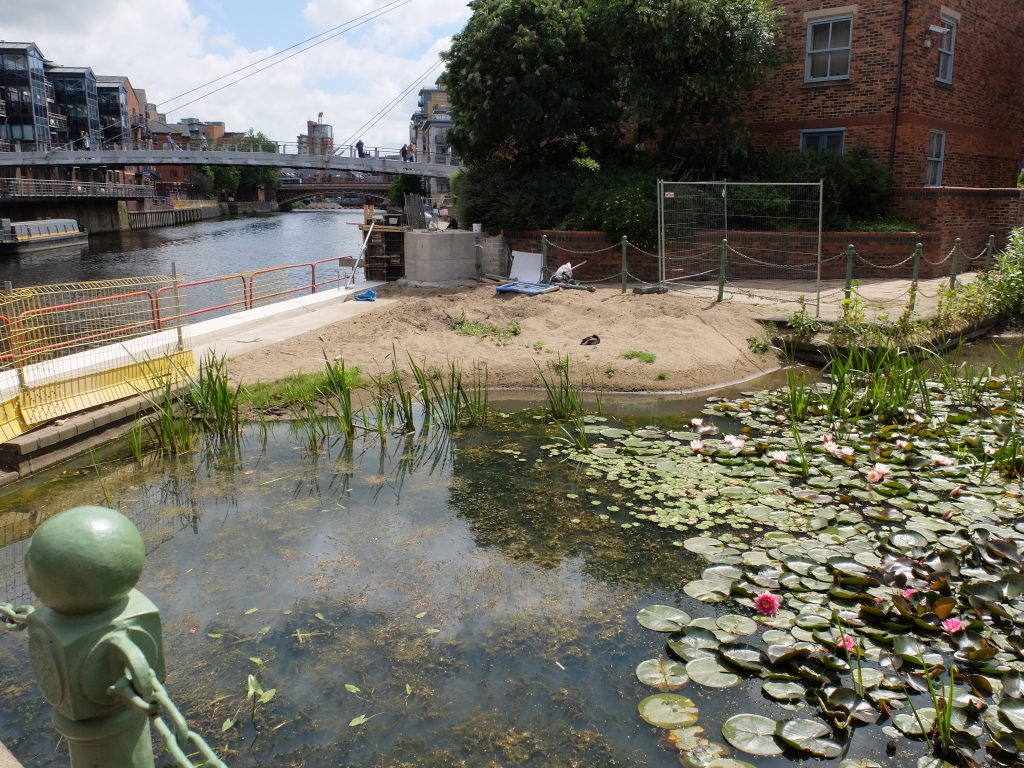 Note also the new concrete flood wall going in at the mouth of the dock. These walls were under construction all around us in 2016. In places, we had to alter our route slightly because sections of path were blocked off by construction fencing. Eddie and Steve had to perform the David Oluwale scene while the whole audience was penned in behind this high fencing that masked off a new section of wall still under construction.
Note also the new concrete flood wall going in at the mouth of the dock. These walls were under construction all around us in 2016. In places, we had to alter our route slightly because sections of path were blocked off by construction fencing. Eddie and Steve had to perform the David Oluwale scene while the whole audience was penned in behind this high fencing that masked off a new section of wall still under construction.
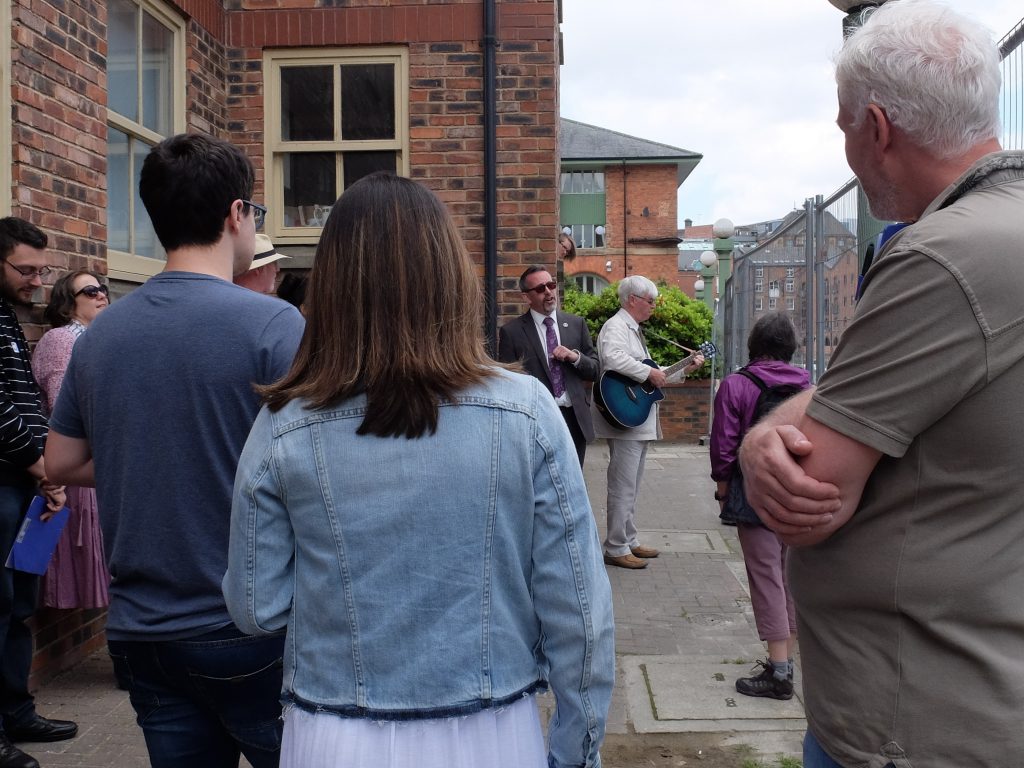
Something about this strange confinement actually further to the deliberate awkwardness of this scene. (One woman was reduced to fighting back silent hysterics during the “Get in the Van” song.)
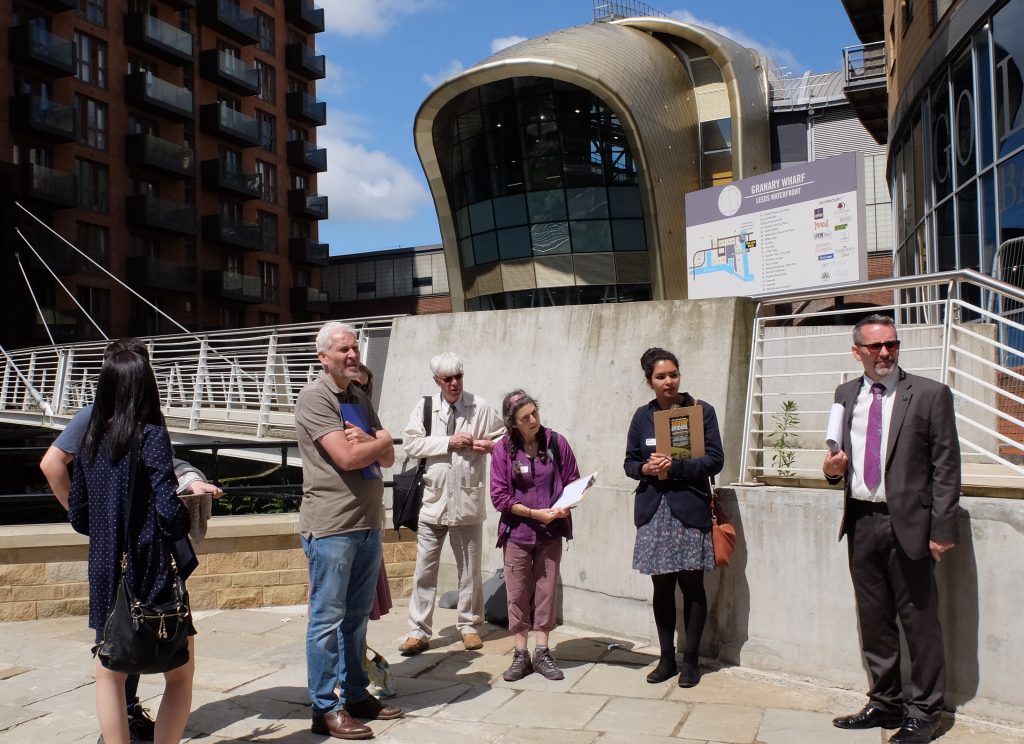 Towards the end of the tour, at Waterman’s Bridge, we were now able to show off the completed gold shell of the new South Entrance to Leeds Station — which had been an engineering construction site during the 2015 festival. (The new entrance featured prominently in our sister piece, premiered at the 2016 festival, After the Flood.) The city’s waterfront keeps right on evolving, re-developing, re-branding…
Towards the end of the tour, at Waterman’s Bridge, we were now able to show off the completed gold shell of the new South Entrance to Leeds Station — which had been an engineering construction site during the 2015 festival. (The new entrance featured prominently in our sister piece, premiered at the 2016 festival, After the Flood.) The city’s waterfront keeps right on evolving, re-developing, re-branding…
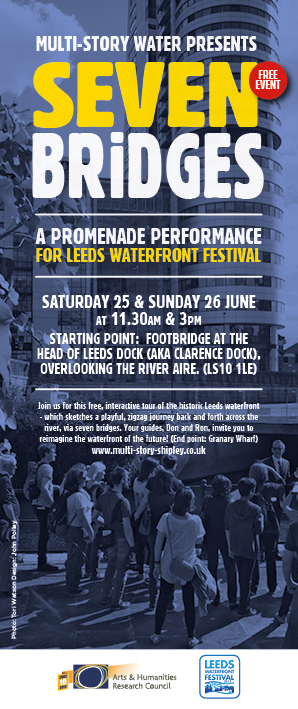 Seven Bridges (Leeds) was devised, written and presented by Steve Bottoms, with devising input from co-performer David Calder, and live music by Eddie Lawler.
Seven Bridges (Leeds) was devised, written and presented by Steve Bottoms, with devising input from co-performer David Calder, and live music by Eddie Lawler.
With thanks to Amy Cunningham, Jasper Llewellyn and Denis Flannery for their valuable feedback on early test-versions of the tour.
Special thanks to Trevor Roberts and Sue Jennings, at Leeds Waterfront Festival.

